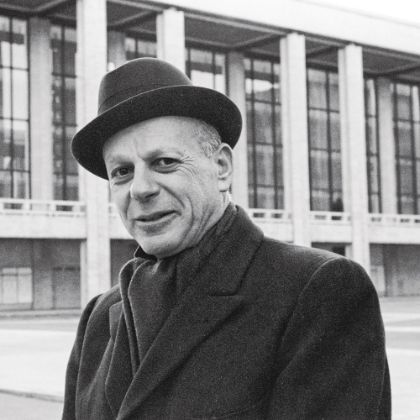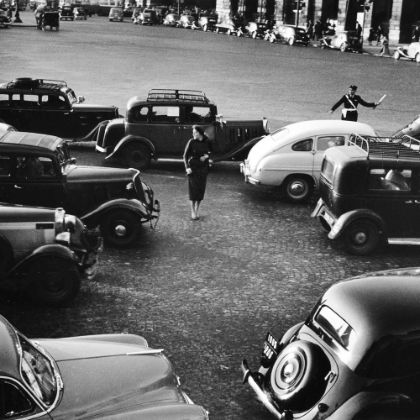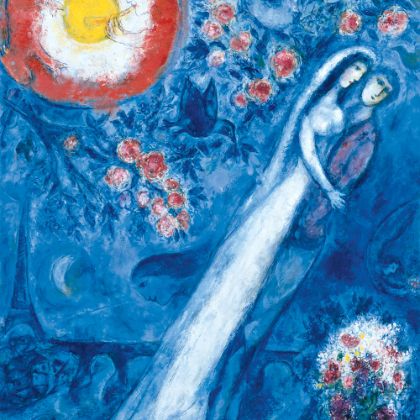The American wind ensemble is quietly building a canon.
By Damian Fowler
At the beginning of Frank Ticheli’s complex and brilliant piece Angels in the Architecture, the first thing an audience hears is the haunting whistle of air produced by three rubber tubes being swung furiously by a percussionist. The otherworldly and delicate sound of tuned wine glasses follows, giving way to a soprano soloist who sings an old Shaker song called “Angel of Light.” Then, and only then, does the brass slide in underneath — a shifting tectonic plate of sound — to destabilize the sonorities just established. There’s nary an oom-pah to be heard.
Ticheli’s piece, which premiered at the Sydney Opera House in 2008 and was released on disc last year, is just one of the many new and daring compositions written specifically for the wind ensemble, or concert band. “It flies in the face of your average Joe’s impression of the stereotypical concert band sound,” says Ticheli, who is a professor of composition at the University of Southern California’s Thornton School of Music.
The American composer has built a reputation as one of the foremost composers of concert band music, which Ticheli says is going through a growth spurt. “Concert bands are building their canon,” he says. “There’s more music happening here than in any other medium.”
It seems the wind ensemble’s image needs a makeover. In the popular imagination, wind bands remain rooted in the European and American traditions of the military band, with heavy emphasis on marches and other ceremonial pieces. Of course, those bands still thrive, including the five bands of the U.S. armed forces, but the wider culture of wind bands is alive with innovation and enthusiasm. “The quality of music for wind bands, and the repertoire, has gotten more and more exciting over the last twenty years,” says Ticheli.
A culture of commissioning is flourishing across the country, most prominently driven not by professional ensembles but university and college wind bands. From the University of Southern California to Texas to Michigan to Indiana to Rutgers, this tight-knit community of musicians is devoted to building and premiering new concert music for winds. “We are the instigators of forming this repertoire,” says Eric Rombach-Kendall, the director of bands at the University of New Mexico. He’s also the president-elect of the College Band Director National Association (CBDNA), which serves — according to its website — as a “dynamic hub connecting individuals to communities, ideas and resources.” The CBDNA is a forum for promoting serious wind music; it organizes conferences, holds competitions for bands, publishes a newsletter and recently sponsored a series of short broadcasts on NPR to highlight wind music in America.
University wind bands are able to commission, according to Rombach-Kendall, because of “the collective effort of the whole community.” College band directors share the common goal of building repertoire, which has led to the forming of consortia between universities, enabling schools to solicit funds together and allowing everyone to buy in to a new work — whether it costs $5,000 or the $100,000+ required for a large-scale work from a big-name composer.
Rombach-Kendall recently organized a consortium to commission a “double trombone concerto” from American composer Joseph Turrin. Written for Joseph Alessi, principal trombonist of the New York Philharmonic, and jazz trombonist Marshall Gilkes, it premieres in April at the University of New Mexico. “I wanted something to mix the jazz and the classical genres together,” says Rombach-Kendall. “We’re really trying to enrich the DNA of our repertoire.”
Another advantage of the consortium system is that the piece will get plenty of outings all over the country from concert bands that bought in to the commission. Says Rombach-Kendall, “For the composer, it’s an opportunity to get their voice heard in, say, fifteen performances,” which, he says, compares favorably with a commission by a major orchestra, where a work may receive only a couple of outings before it goes to the archive.
This fact is not lost on major composers whose work for wind bands gets played and played. Colleges are not bashful about commissioning works from the likes of William Bolcom, whose First Symphony for Band was premiered in February 2009 by the University of Michigan’s Symphony Band. Other popular composers include Joan Tower, whose notable work includes Fanfare for the Uncommon Woman, scored for three trumpets, four horns, three trombones, tuba and percussion, and John Corigliano, who wrote Circus Maximus — Symphony No. 3 for Large Wind Ensemble.
In his program note to the piece, published in 2004, Corigliano’s thoughts on the wind band are worth quoting at length:
The repertoire of band music is largely contemporary. As a result, the audiences expect and look forward to new works. Listening in an environment largely ignored by the press, they learn to trust their own ears and respond directly to what they hear. Most important of all, concert bands devote large amounts of rehearsal time over a period of weeks — not days — to learning thoroughly the most challenging of scores.
The composer John Mackey wrote an amusing blog about the joys of writing for band instead of orchestra. At the beginning, every composer flirts with Orchestra, he writes, because it’s the most alluring — but then along comes Band, who “loves what you do. Whereas it was like pulling teeth to get Orchestra to look at your new music (and if she looked, she was generally not impressed, often comparing you unfavorably to one of her many exes, like Dvořák), Band thinks it’s awesome.”
What makes composing for wind bands all the more urgent is that the repertoire for concert band music is much smaller and younger than that of the orchestra. “We’re not like the symphony orchestra, with thousands of pieces written over centuries,” says Rombach-Kendall. To be sure, even in Mozart and Haydn’s day many of the great courts of Europe had so-called Harmonie bands, which played for outdoor and recreational events. In a letter to his father, Mozart even mentions that street musicians had serenaded him with his own composition, the Serenade in E-flat Major, K.375, which was scored for two oboes, two clarinets, two bassoons and two trumpets.
But the modern idea of a concert band developed somewhat later, in the nineteenth century. “The thing that changed wind bands and enabled them to move into a new era of music-making was the industrial revolution,” says Robert Foster, a professor of music at the Kansas University School of Music and the author of the upcoming book Band — A Historical Perspective. “As the technology evolved, people started to write more sophisticated music for wind instruments.”
But it wasn’t until 1909, when the English composer Gustav Holst wrote his First Suite in E-flat major for Military Band (Op. 28, No. 1) and then a sister piece, Second Suite in F for Military Band, that the concert band repertoire really came of age. Until then, most pieces for concert winds, with a few exceptions, were transcriptions of symphonic works. As the twentieth century progressed, major works for wind ensembles entered the canon, notably Stravinsky’s Symphony for Winds (1920), Paul Hindemith’s Symphony in B-flat (1951), Arnold Schoenberg’s Variations, Op. 43a (1943) and Percy Grainger’s masterpiece Lincolnshire Posy (1937), which attempts to render English folk music in a modern concert band setting. Essentially, the core repertoire is just over a hundred years old, so the hunger for new material is not surprising.
Concurrent with all the commissioning activity is a concerted effort to record and promote this new music. “I feel the wind band is the next generation of classical music,” says Mark J. Morette, who runs his own record label of more than a hundred and forty entries. He has recorded wind bands from all over the country, including a superb version of Respighi’s Roman Trilogy, transcribed for winds and performed by the United States Air Force Band, that he considers the best band CD ever. His label also records newer works for wind band, including several discs featuring the music of Frank Ticheli.
“We love to record,” says Morette, who is keen for wind ensembles to be recognized by the National Academy of Recording Arts and Sciences in their own Grammy category. “We have tried hard, but we’re lumped in with the Orchestra category. We don’t get a lot of love from radio stations.”
Four years ago, classical label Naxos started its own Wind Band Classics label with a disc featuring John Mackey’s Redline Tango, still one of the most popular in the series. “Until recently there hasn’t been any real push for band recordings,” says Randall Foster, who created the series for Naxos. “The interesting and wonderful thing it has done is to put music from American wind ensembles on a global platform.”
Foster’s goal is an ambitious one: to “record everything ever written for band,” he says. He’s forging ahead enthusiastically. This year Naxos will release Christopher Rouse’s Wolf Rounds, which premiered at Carnegie Hall in 2007 and looks likely to be the hot item for the spring, at least in the band world.
The wonder of this creative surge is that most of the bands playing (and recording) new repertoire are not professional, but highly skilled university and college ensembles. “We can be a lab for this new art,” says Eric Rombach-Kendall. “We don’t have the pressure of selling tickets and subscriptions [like a professional symphony orchestra], so it’s more than just entertainment.”
There are some notable professional bands, especially in Texas, the home of the Dallas Wind Symphony and the Lone Star Wind Orchestra. But the majority of wind ensembles are to be found under the umbrella of the university, where they continue to thrive.
School bands really flourished in the United States after World War II and have become a fixture at football games and other athletic events. “The school band is an American phenomenon,” says Robert Foster, who explains that the model has been exported all over the world to countries from Sweden to Japan. Bands initially developed out of a huge social need for recreational groups playing music on durable instruments suited to the outdoors, which created opportunities for wind and brass players. These “social organizations,” as Foster calls them, eventually morphed into some of today’s very sophisticated ensembles.
Some music students are still attracted to the idea that a wind band can have great social utility. Just last year, Steven Behnke, a twenty-five-year-old undergraduate French horn player at Manhattan School of Music, founded his very own wind ensemble in New Jersey, Patriot Brass. It’s a flexible unit of brass instruments that specializes in music for veterans and patriotic music of the United States. “I feel we’ve lost a lot of our function in society,” says Behnke, who is well versed in the concert repertoire but feels the wind band should not drift too far from its social mandate, which might include playing service hymns on Memorial Day or the bugle call “Taps” at the funeral of a war veteran.
Their immediate social function notwithstanding, college bands have evolved significantly since the 1950s. But what really opened up the field for the symphonic concert band was the establishment of the Eastman Wind Ensemble in 1952 by Frederick Fennell. Since its founding it has premiered more than a hundred and fifty new works for winds and helped popularize many more. Jazz trumpeter Wynton Marsalis has even sat in on occasion. “It provided a new kind of role model,” says Donald Hunsberger, who led the ensemble from 1965 to 2001. He argues that by raising the musical bar high, the Eastman Wind Ensemble made composers want to write for them. “It created the notion that the wind ensemble is a musically serious affair and should be taken on the same basis as any other classical unit.”

Photos: Senior Airman Tim Chacon, Courtesy SSgt Rachel Ghadiali, US Marine Band, Jonathan Kirn, Senior Master Sgt. Robert Mesite
related...
-

Master Builder
His compatriots made institutions of their music. William Schuman made institutions.
Read More
By Russell Platt -

Respighi: Beyond Rome
Respighi’s set of variations is cast away for his more
Read More
‘Roman’ repertoire.
By David Hurwitz -

L’amico Fritz
Mascagni delivers beautiful music, libretto be damned.
Read More
By Robert Levine